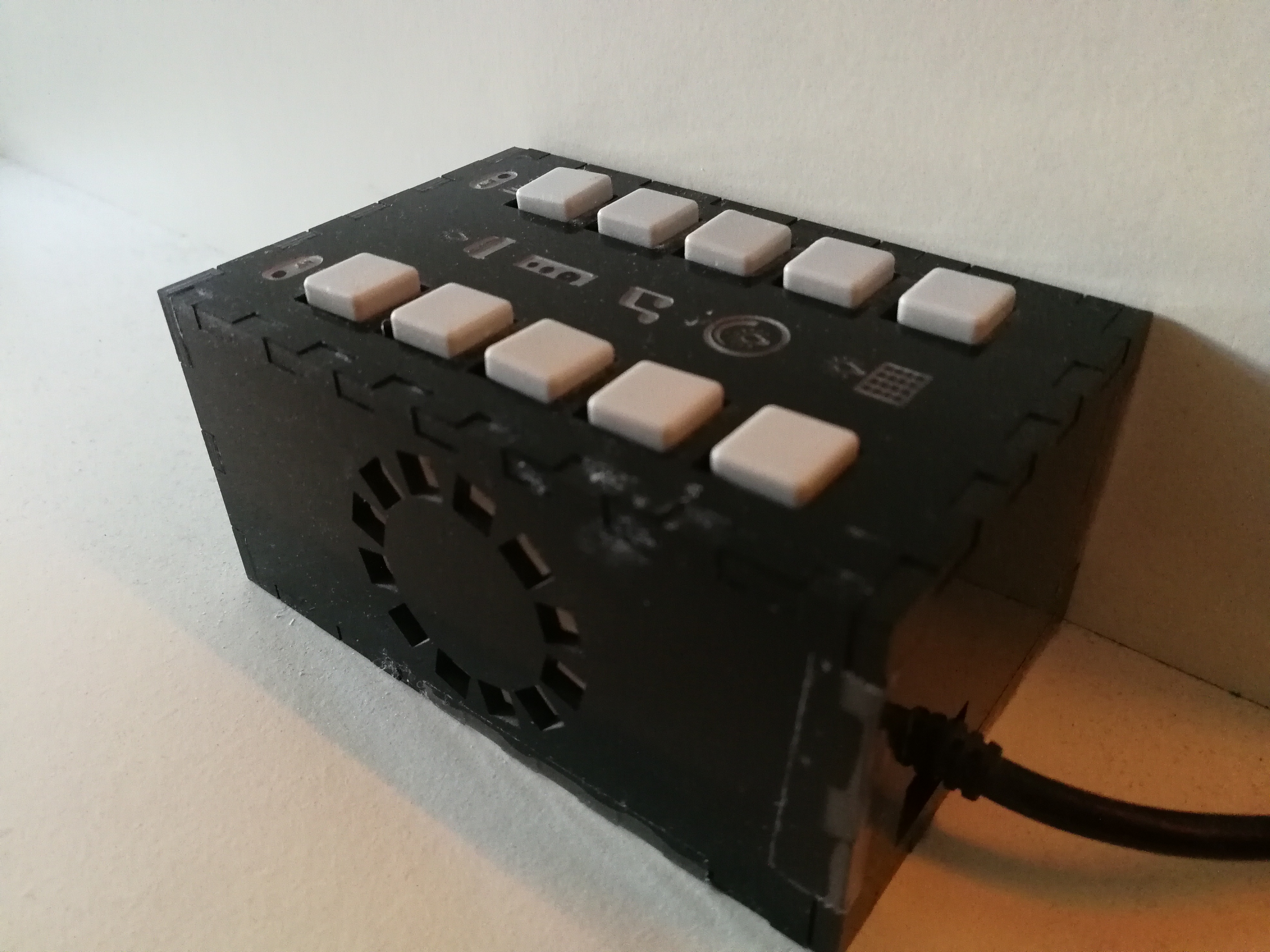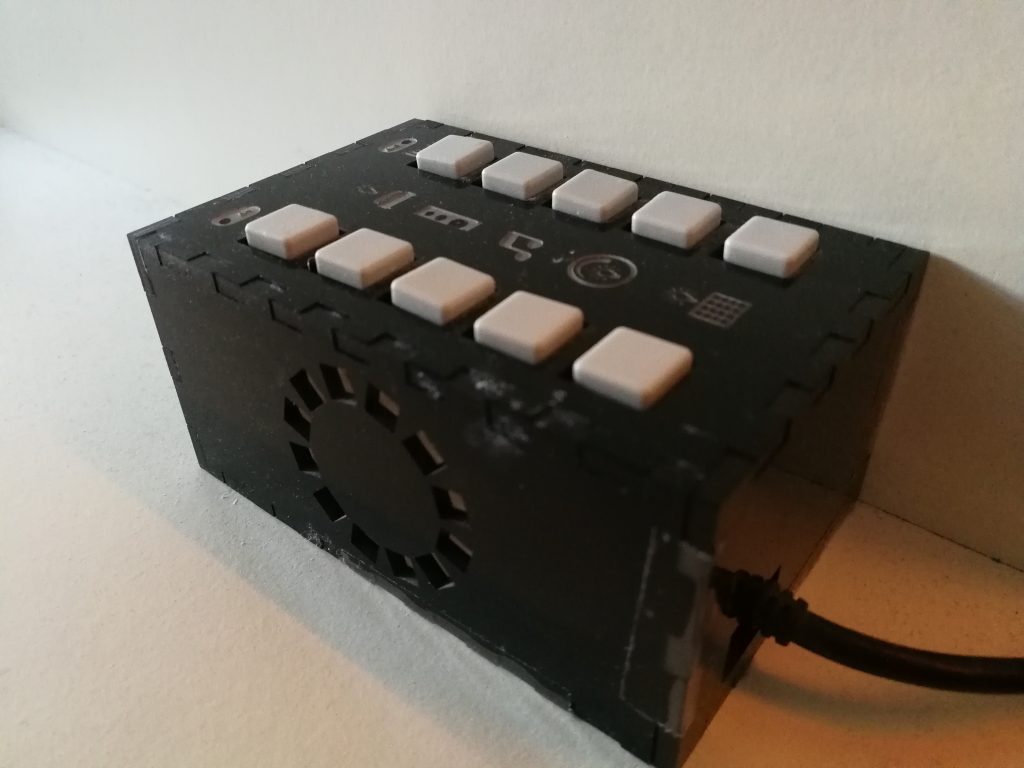inaccessible due to cooperation with the Robert Bosch GmbH
-

Software
Spark renamed themselve to Particle and released a updated version of the Spark Core: the Particle Photon. Additionally they published a desktop IDE called Particle Dev.
To support the Particle Photon and the Particle Dev I removed the firmware part of our smartswitch code. You can find the result on github.
Hardware
Additionally I refactored the buttons and the case of the smartswitch since the button pad is not as usable as expected. I replaced the button pad with some push buttons and the WS2812s LEDs with a neopixel ring.

-
OSMC
Since Raspbmc is no longer under development I upgraded to the enhancement called OSMC.
IR-Remote
After installing OSMC on my SD card I tried to enable the device tree overlay for the GPIO IR Remote. This can be accomplished in the OSMC Settings Plugin or in the file /boot/config.txt by adding:
dtoverlay=lirc-rpi:gpio_out_pin=17,gpio_in_pin=18
Furthermore you need to delete the lircd.conf in /etc/lirc and store your version created for the remote at /home/osmc/lircd.conf. It is important to edit the “name” entry.
To enable the key functionality you need to add a Lircmap.xml to map the keys.
More information can be found in the entry on the OSMC forum: https://discourse.osmc.tv/t/rpi2-osmc-alpha-4-and-ir-gpio/483/12You will need to configure a Lircmap.xml file and place it in /home/osmc/.kodi/userdata folder.
If there is none avaialable there, take the default one from here
/usr/share/xbmc/system/
and modify it.
Keep only one entry and make sure that the LIRC button names are correct (keep onet hat has KEY_LEFT, KEY_RIGHT, etc. in it).
Make sure you use the same name for the remote device name with the one configured in /etc/lirc/lircd.conf (if it’s generated, the name is the path where it was created. Feel free to rename it to something more handy, like ‘myremote’)
More info here:
http://kodi.wiki/view/Userdata/lircmap.xml27
Place the edited Lircmap.xml file in the /home/osmc/.kodi/userdata/Lircmap.xml and then restart kodi (or the RPi).Ambilight with Hyperion
To enable the ambilight functionality I replaced Boblight with the lightweight Hyperion. The installation and configuration process is described in the wiki: https://github.com/tvdzwan/hyperion/wiki/Installation and https://github.com/tvdzwan/hyperion/wiki/Configuration.
Unfortunately the LEDs weren’t working in my setup. To debug the hyperion process you can start it with
sudo /usr/bin/hyperiond /etc/hyperion.config.json
While debugging I found a XBMC Connection Error (0) which is described in the forum: https://discourse.osmc.tv/t/rpi2-hyperion-osmc/449/43
The solution is to create a init script in /etc/systemd/system/multi-user.target.wants/hyperion.service
[Unit] Description = hyperion After = mediacenter.service
[Service] User = osmc Group = osmc Type = simple ExecStart= /usr/bin/hyperiond /etc/hyperion.config.json Restart = always RestartSec = 1 [Install] WantedBy = multi-user.target -
Abstract
Applications for automatic identification of objects in scene images, called auto-tagging, range from image database organization over visual search to e-commerce. In this paper our effort to identify specific pieces of furniture in cluttered scenes based on ideal models using object recognition techniques are discussed. The extraction of local features and naive nearest neighbor matching followed by a geometric verification are compared to the Bag of Words (BoW) and the Spatial Pyramid Matching Kernel (SPMK) approach. As expected the naive matching of local features generated the worst results whereas the SPMK method yields the best results and was therefore closer examined. We propose a spatial based, additional layer weights of weight to be added to SPMK for this specific application. Our results still not satisfy the desired use case, reliable recognition of furniture, but can be used as lead for further research. -
Abstract The following paper discusses security threats and aspects in Radio Frequency Identi fication and Near Field Communication. Therefore Privacy-Violations, Authentication problems, problems with low-cost RFID Tags and basic threats like destruction are explained. Furthermore eavesdropping, data corruption, modifi cation and insertion are a security threat in the communication. Only a Man-in-the-Middle attack is complicated to implement for an attacker
